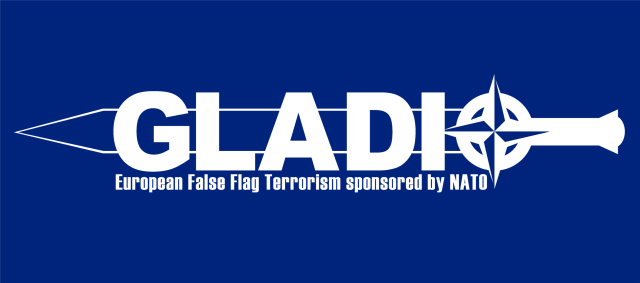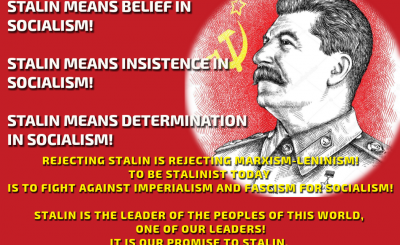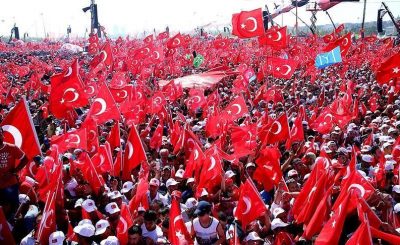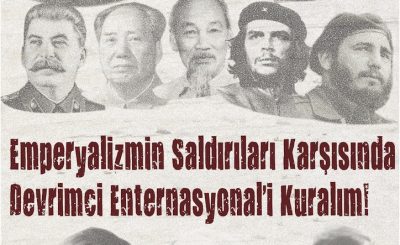For securing the existence of the state, all means – massacres, provocations, torture, and all kind of cruelties – are justified. This view is the basis for the organisation and the manner of operation of the contra-guerrilla, and this determines their degree of unlawfulness. The contra-guerrilla should not be conceived as an organisations which destroys and burns down everything, which commits massacres and plans provocations and intrigues. Of course, in their war against the people they’ll make ample use of these methods, but this is just one side of the medal in this war. The contra-guerrilla should be conceived rather as one of the many organisations which were set up for the war “against the people, it should be seen in the context in the entirety of this war, waged on several levels by these organisations to oppress the revolutionary struggle. This was is a total war, and with its economical, democratic, political, ideological, psychological and military dimensions, it covers almost all fronts. With the growth of the revolutionary struggle, the contra-guerrilla will apply new means, that’s the rule of war. The “Village Guards” (the para-military) – set up after 1985-, the increasing number (since the beginning of the `90s) of executions, mass murders, kidnappings, murders by “unknown perpetrators”, the institutionalisation of treason (deserters), the growing activities if undercover agents and informants, the special teams, the legalisation of the village guard system, the recruitment of special teams, the state of emergency, and the anti-terror laws constituted, together with all the other attacks, an increasing aggression by the contra-guerrilla, opening the total war against the people.
EXECUTIONS, DISAPPEARANCES AND THE VICTIMS OF “UNKNOWN PERPETRATORS”:
Executions, abductions, and murders by “unknown perpetrators” were “practices” of the contras which intensified rapidly after 1991. This development did not come out of the blue sky, of course. 1990 and 1991 were the years Devrimci Sol rose quickly. The strengthening of the revolutionary opposition shocked the oligarchy on its foundations with mass protests, dozens of armed actions and punishments. The Kurdish national movement, which they said to “exterminate” “in spring” could not be exterminated. Furthermore, 1990 and 1991 were the years of the mass protests and the “Intifadah” in Kurdistan. The state, feeling cornered by the expansion of the revolutionary movement and losing its psychological superiority, initiated a new wave of aggression. The chapter of disappearances started with Yusuf Eristi, taken into “custody” on May 14, 1991, in Belgradkapi-Istanbul. Although witnesses testified they saw Yusuf Eristi in the police station, the police never acknowledged officially that he had been arrested. Since then,. the reports about “disappearances” increased continuously. Although the exact number is unknown, the balance of the past three years shows more than 400 people who disappeared. Between 1980-1991, there were just 13 cases, in 1991 4 people disappeared, in 1992 there were 8, and in 1993, as far as can be established: 23. This means that there wasn’t a “systematic policy” of “disappearances” in that period, whereas the number of “disappearances” grew explosively since 1993 and disappearances, as a method of the contra-guerrilla, became calculated state policy. In 1994, 24 people disappeared. Furthermore, 229 people were “abducted” in Kurdistan and they were never seen again. In 1995, 213 people disappeared in police custody. The method is a CIA method. In earlier years they tested and applied this method in other countries, such as: * Guatemala: since 1966, tens of thousands of people were abducted of killed by the state. * Uruguay: the Junta, seizing power in June 1973, had thousands of revolutionaries disappeared in the depths of the jungle and in the sewers. * Chile: General Pinochet, who overthrew the government of Allende, elected by the people in 1973, imprisoned thousands of revolutionaries and opponents in stadiums and had them massacred. * Argentina: The generals took power in !976. The junta arrested and killed an estimated 30.000 people. Thousands were thrown from planes into the sea. * Peru: In the past 10 years, some 4.500 people disappeared in a systematic policy.
Why did the Turkish state think it necessary to apply such a policy as well? There are many possible answers. The method of disappearances was preferred to imprisonment and uncertain convictions, and as phrased by the leader of the coup, general Evren: “Should we feed them in stead of hanging them?” As a conclusion, this is certainly accurate, but the goal is not merely the physical annihilation of the opposition, they also want to intimidate the people. The “murders by unknown perpetrators” are used as an element of psychological warfare. Revolutionaries, democrats and patriots are taken away from their houses, their work, or from the street, and their dead bodies are thrown in ditches or river beds, usually after torture. The marks of torture are usually clearly visible and the contra-guerrilla does not make any effort to hide the bodies, they are rather put at places where they are easily found. Not as if they wouldn’t have time to “hide” them. The state officials, time and time again, swear that the police, the security organs, act against terror “within the framework of the law”, but the contra-guerrilla openly shows its impudence, they will not be hindered by a law or a decree to massacre and torture.
The rise of the number of executions since 1991 is a result of this policy. The murder of the Dev-Sol fighters Olcay Uzun and Faruk Bayrakci on April 9, 1991 in Izmir, of Hatice Dilek and Ismail Oral on May 19, 1991 in Bayrampasa-Istanbul, of Perihan Demirer on May 28, 1991 in Besiktas-Istanbul, and the massacre of 11 people (among them 10 Dev-Sol members) on June 12, 1991 in Balmumcu, Nisantasi, Dikilitas and Yeni Levent-Istanbul, revealed that the state developed its policy of executions into a systematic general policy. Since then, hundreds of alleged revolutionaries and patriots were murdered all over Turkey under the pretext of razzias against revolutionary cells. The aim was to kill them, not to arrest them. Weapons were placed next to unarmed people to suggest an armed confrontation. The executions went as far as targeting democratically working sympathisers and supporters. One of the most recent examples was the murder of Irfan Agdas, in the middle of the street, who was distributing the Kurtulus weekly. In a similar manner patriots in Kurdistan, teenagers, who distributed the papers Ozgur Ulke and Ozgur Gundem, were murdered. The policy of executions was not restricted to the major cities, it was a state policy which covered the whole country. The state took a stand of totally annihilating the guerrilla, of not taking them alive. Except for those who surrendered themselves, they started the execute the guerrillas who were captured alive after a fight, in stead of arresting them. The executions and massacres were extended from the guerrilla to the village population, suspected of logistically supporting the guerrilla. People who were taken from their villages, or who were summoned to the police station, were never seen again or their bodies, often tortured, were found next to the street. Looking at the increasing number of executions and “murders by unknown perpetrators”, one recognises -besides the physical annihilation-, that the state wants to unleash a wave of terror among the opposition. It’s their intention to intimidate, to subdue the revolutionaries, to make them drop their goals, to show them what they have to expect in case they continue their struggle for the people, against the state. The massacres of the past years in the prisons of Buca, Umraniye and Diyarbakir must be seen in this context as well. The people were imprisoned already, but it’s not the detention that counts for the contra-guerrilla, it’s the resistance. They want to break the resistance which they can not suppress by attacks, culminating into mass murders. This is a threat, not just to those in prison, but also to those who continue the struggle on the outside. The message from the contra-guerrilla to the revolutionaries and patriots is this: “Don’t belief you’ll only have to come through the torture alive, we can kill you in prison any time we want. In here, there is no guarantee for your life.” Like us, all revolutionaries, democrats and patriots know about the high price for revolutionary work in a fascist environment. taken into custody and getting tortured, being arrested and thrown into jail, falling in the struggle against the enemy. These are almost natural consequences of the struggle and the confrontation with the enemy. As a revolutionary, ones accepts this price and one takes a stand in this struggle. But the contra-guerrilla wants to increase this price with its practice of oppression, terror, massacres, disappearances, executions, “murders by unknown perpetrators”, and by demonstrating that they are not bound by laws or judicial regulations, they want to erect a wall of fear in the minds, not just of those who are directly active in the struggle, the guerrilla and the militias, but rather in the minds of all, also those who work in the democratic field, revolutionaries, patriots, democrats and even normal workers, union members. Although it is impossible for them to kill all revolutionaries, patriots, sympathisers and supporters, they want to tell the people this: “To get killed, kidnapped or beaten to death, it’s not necessary to carry a weapon yourself.” To become a target for the contra-guerrilla, it’s enough to distribute a revolutionary paper of magazine, to be active in a legal association, to show solidarity with the revolutionaries. Because it’s the law of the contra-guerrilla not to know any laws. They lost all measure for guilt and punishment, for them an enemy is just an enemy, no matter what he has done, no matter whether his deeds are punishable be present law, or not. An enemy is an enemy, and all kinds of punishment are justified. And thus: “Watch your steps, if you’re a revolutionary, then quit. If you’re not, then keep away from them, do not participate in acts against the state, otherwise it will end badly for you.” Well, now the questions arises whether the state succeeds with this policy, or whether the true character of the state is revealed even more forced because of this policy? The state applies more modern methods and develops new strategies to get results at any price, an act which also means the failure of its formerly practised strategy to suppress the revolutionary struggle. It did not succeed to suppress the revolutionary, democratic opposition with its policy of extra-judicial executions, the murders by “unknown perpetrators” and the disappearances. But claiming that this policy has had no effect at all on the people would be extremely optimistic. It has played a “constraining” role in certain places. It’s obvious that the spread of fear and the height of the “price” which has been paid, caused the strengthening of the tendency of the petite-bourgeoisy, who did not separate themselves totally from the system, even of the petite-bourgeois revolutionary organisations, to return back to the system. As often as the state denies this policy, it can not prevent its revelation. To lengthen the “life” of the status quo, of having to choose between preventing a revolution and risking to get exposed, it chooses for the latter, of course. It’s forced to take these risks, because it does not have the capability and the reserves to invoke democratic and economic reforms to fulfil the needs of the people. And so it does not have an alternative but to suppress the opposition, the people, by repression and terror.
IS IT POSSIBLE TO PREVENT THE MASSACRES, THE “DISAPPEARANCES”, THE MURDERS BY “UNKNOWN PERPETRATORS”?
One must realise that a total elimination of this policy of terror is not possible. Not only in countries, like ours, were fascism controls the state, but even in the bourgeois democracies in Europe a total prevention of these practices has been impossible. They are particularly applied against organisations which advocate the armed revolutionary struggle.
The absolute elimination of this policy is only possible through a revolution. Only a revolution is capable to end this terror system of the ruling classes. But this doesn’t mean that this state policy can not be restrained, or even “paralysed”. It is possible. The panacea is constant engagement and insisting on the struggle. Because the goal of all the aggressions by the enemy is to crush the struggle. Exposing the state is important, of course, but in itself it will remain useless. When we are capable to expand the struggle despite all the offensives by the state, it’s policy will collapse. We will confront every attack by the enemy with resistance: when they attack our bases, we will continue our tradition of surrendering never, when they attack our democratic positions, we will not clear the way. We will stand up even more for our “disappeared”, the murdered comrades, the revolutionaries, the democrats and the patriots. Despite all the aggression, we will continue to organise the people, to connect it with the struggle. With achieving this goal, the policy of the enemy will collapse, they will only succeed in turning all their attempts into a weapon which will turn against them.
APPENDIX
SOME OF THOSE WHO “DISAPPEARED”:
HUSEYIN TORAMANHe left his house in Istanbul, Kocamustafa Pasa Demirci Sokak nr. 8/1 on October 27, 1991 to do some shopping. In front of the people, and his wife, he was dragged into ca car, license plate 34 AT 256, and kidnapped by 3 plainclothes policemen. From October 29, 1991, all questions to the authorities remained unanswered. He was never seen again.
ISMAIL HAKKI KOCAKAYA He was arrested on November 23, 1991, in Diyarbakir when he was taking a walk with his family. People in civilian clothes, claiming to be policemen, dragged him into a car, license plate 21 E7 916. His body was found on November 27 in the region of Karadag. It was established that the car which was used in the kidnapping was part of the car park of the police directorate of Diyarbakir.
AYHAN EFEOGLU He was arrested on October 6, 1992. Although those who were arrested at the same time testified Ayhan Efeoglu was in police custody, his arrest was not admitted by the Political Department of the Police Directorate in Diyarbakir.
AYSEL MALKAC As a fellow-worker and reporter of the paper Ozgur Gundem, she went on her way on August 7, 1993, to do some research. Since then she was not seen again. All questions remained unanswered. The police denies to have her arrested until today.
LUTFIYA KACARShe is disappeared since October 5, 1994. Although policemen of the Anti-Terror Department in Istanbul phoned the Kurtulus office and said Lutfiya Kacar was in their hands and that they were going to make her “disappear”, all inquiries at the proper authorities remained unanswered until today.
BEHCET CANTURK A Kurdish businessman. Found dead on January 15, 1994, in Spanca, a suburb of Sakaraya.
KEREM GENCER Kerem Gencer, a clergy, was found dead on January 17, 1994, near the village Tatvan in the region of Kirkbudak.
YUSUF ZIYA EKINCI A lawyer in Ankara and member of the Lawyers Guild. He was also the lawyer of Behcet Canturk, a Kurdish businessman who was also murdered. Yusuf Ziya Ekinci’s body was found near Golbesi-Ankara.
MEHMET SERIF AVSAR. A merchant. Found dead on May 7, 1994 in the village of Tepebasi, near Diyarbakir.
IKRAM MIHYAS Unionist. His body was found on July 6, 1994, in the village of Yaka, near Izmir.
THE IDEOLOGY OF THE CONTRA-GUERRILLA IS BEING FED WITH FASCISM.
“We should hang them, in stead of feeding them”, said junta chief Kenan Evren, having the revolutionaries in mind. In December the general staff handed over its “Kurds report” to the government. This report is based, from the beginning to the end, on racist propositions. The report states that the Kurdish population is growing very fast and that measures are needed against this. The entire Kurdish population is seen as an enemy. If we look closely, we see the MHP (Grey Wolves) behind the Mafia and the contra-guerrilla. The assertion that there are more fascists like Catli who are being used by the state is proofing to be more and more accurate. It is known that the contra-chiefs Mehmet Agar, Kemal Yazicioglu and Ibrahin Sahin belong to the MHP or have close ties with it. The members of the Special Units who’ve committed gruesome massacres like cutting of ears and noses, chopping of heads, torturing and raping their victims, are almost all MHP-fascists. Before September 12, 1980, the fascists killed hundreds of revolutionaries and democrats. They attacked workers on strike. Nowadays it are the fascists again who attack the revolutionaries and democrats in the schools and universities. Is it mere coincidence that all of them, from the contra-chiefs till the school officials are racists? That they look at all those who have a different opinion as the enemy? Of course not. The contra-guerrilla as well is based on an ideology from which it draws its strength: the ideology of fascism. It doesn’t matter whether of not a contra-guerrilla member belongs to the MHP, their ideology is always the same. Because they all serve the same goal. Under the pretext of protecting the state, they use all means to defend the interests of the oligarchy and the system, keeping the regime in power. So they play the role they were given: continuing the gruesome policy of fascism.
THE COERCION TO SPY.
In the regions and places where the revolutionary struggle is rather intensive, spying has become one of the activities of the contra-guerrilla. They try to expand their network of spies, anyway they can. In this manner they try to gain control over these regions, receiving immediate information about revolutionary activities. They want to expand this possibility as far as possible. The spies are usually selected by people who live or work in these areas. All intelligence services, the contra-guerrilla, and even the policemen at the police station try to set up a network of spies of their own. At first, they try to find volunteers among the reactionaries, the state loyalists, or the fascists. They prefer people who live among the population and who quickly receive information about developments in the region. Village chiefs and small merchants are intensively canvassed. Those who are not prepared to spy voluntary, are promised personal advantages. As a last resort, repression and threats are applied. In the rural areas, especially the village chiefs are forced to spy. These people receives telephones or even radio equipment. The network, consisting of the village chief and other inhabitants, also has a structure of its own. Networks of spies are also set up in state institutions and factories. An example: to secure his livelihood, a spy could be employed as a workers or a foreman in a factory or a state institution, working at the same time as a police spy. Street merchants are often used in this manner. It’s difficult to unmask a spy in case they do not have open contacts with the police. Like anybody else, they do their job. In the end they only have to pick up the phone. The best precautionary measure is to known the people in our environment very well, watch them closely, something which is necessary anyway when we work with the masses. But we should not see all people, especially not all the right-wing people, as spies. Furthermore, we should only carry out our activities overtly as far as is needed, also in the legal work. We should not discuss certain information in the presence of others and we should not unnecessarily disclose connections. Before every action and every protest we have to realise ourselves that denunciations could occur and appropriate security measures should be taken. Our people has always objected every kind of spying and collaboration. It’s no coincidence that the police chiefs complain now and again about the lack of support among the population. This doesn’t mean that the police is not continuing its spy activities. In case a spy is unmasked, he should be presented to the people and be punished, we can not allow to legitimise spying.




